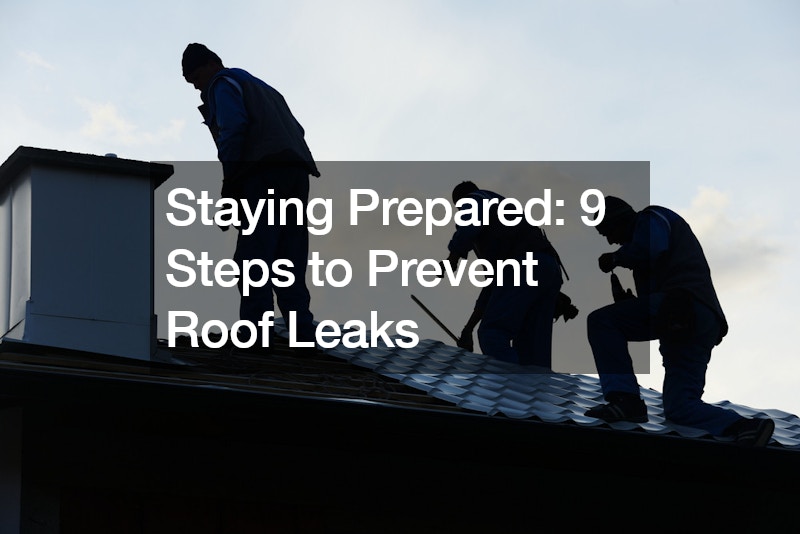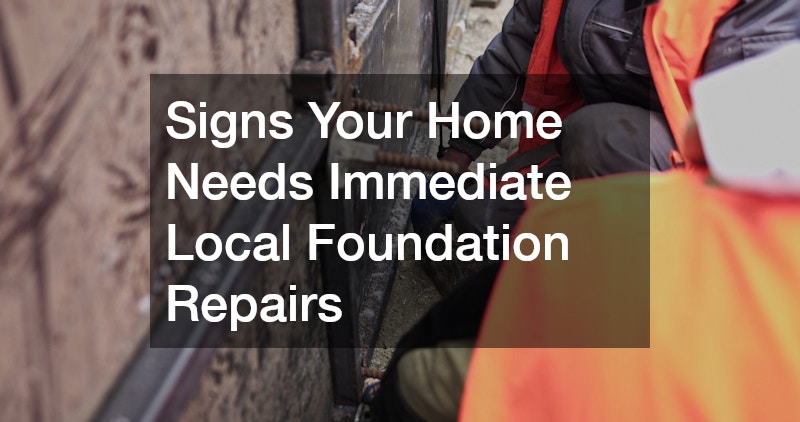Taking the appropriate steps to prevent roof leaks is a necessity when you’re a homeowner or when you invest in any type of properties, including commercial locations. If you’re determined to prevent water damage or the need for a replacement roof far too early, you can incorporate various steps to prevent roof leaks in your own home maintenance routine and schedule. The more familiar you are with the causes of roof leaks, regardless of the type of roof you have installed, the easier it’ll be for you to pinpoint how to go about remedying the issues at-hand before it’s too late, or before it becomes too costly for a repair or replacement.

1. Schedule Routine Inspections
Before calling a professional roof repair service, you’ll want to schedule or conduct routine inspections of your roof to ensure you’re not at risk of a major leak or standing water. Scheduling routine inspections is one of the most crucial steps to prevent roof leaks, especially when you’re unable to inspect the roof of your home or commercial building independently. Working with professionals who specialize in roof inspections is also a way to determine the overall condition of your roof based on current materials in place, age, and general wear and tear.
Routine inspections can also help you determine if your roof is missing any shingles (especially in the case of an asphalt roof) or if your roof’s flashing is damaged and requires repair or replacement jobs. Routine inspections can prevent major damage that is also linked to missing shingles, gutters, and even fallen debris. When you schedule routine inspections, it’s much easier to maintain your peace of mind as a property investor or homeowner. With a routine inspection, eliminate the guesswork involved in maintaining a roof, regardless of the size, slope, and type of roof you have installed.
2. Remove Debris and Fallen Trees After a Storm
Another one of the most vital steps to prevent roof leaks is to remove debris that may have fallen on your home, especially after heavy rain, storms, or in some cases, even a natural disaster. Removing debris and fallen trees from your roof after a storm will alleviate pressure and weight on the roof, which can reduce the risk of long-term or permanent damage to your roof’s current structure. If you’re unable to reach fallen trees or debris on your roof, you can always turn to local roof repair services to inquire about removal services and options that are ideal for your needs.
Even if you don’t believe the debris on your roof is significant, it may cause issues if it’s left alone over time. When debris, trees, and other items are left unattended after a storm, they can place unnecessary additional weight onto the roof and its joints, which can weaken the structure in a shorter time. Inspections and routine debris removal services will help keep your roof clean and clear from any potential issues or obstacles that may cause a problem in the long run.

3. Maintain Nearby Trees and Foliage
When you’re making a list of steps to prevent roof leaks, you’ll want to keep an eye on nearby trees, foliage, and any greenery you have near your home and on your property or lot. Maintaining the trees and landscaping that surrounds your roof will mitigate the risks of fallen branches and other debris that can cause damage to the foundation of your roof. It’s also important to note that if you’re thinking of filing roofing claims after a storm or serious damage occurs, you’ll need to ensure your roof is cleared of obstacles and surroundings that may be the root cause of the problem.
Anytime you have a home or property with trees, foliage, and overgrown branches, you’ll need to keep them from touching your home or hanging over your roof. Even if you believe the foliage to be in good, healthy, condition, there’s always a risk of a potential fallen branch or debris that can impact the structure and condition of your roof. When you’re working with a local landscaper or landscaping company near you, be sure to inquire about your options to prevent overgrown trees or branches from touching any area of your roof.
4. Regularly Inspect and Clean Gutters
Maintaining residential roofing requires more than simply inspecting shingles and replacing damaged flashing as needed. You’ll also need to pay close attention to your home’s gutters if you’re determined to prevent a leaky roof, standing water, or even clogged gutters that can wreak havoc when left alone. When it comes to incorporating steps to prevent roof leaks, regular inspections and cleanings of your gutters is a must.
Cleaning your home’s gutters and inspecting them seasonally is ideal, as it provides insight into the current state and condition of any gutter system you currently have installed around your home. Routine inspections will also help you identify potential cracks where leaks are more likely to occur or where permanent damage may occur. If you’re unfamiliar with the process of inspecting and cleaning your home’s gutters, you can also turn to local roofing contractors to streamline the process with the proper safety gear, equipment, and tools in place.

5. Repair and Replace Flashing
If you’re making or reviewing a list of steps to prevent roof leaks, you won’t want to forget your roof’s flashing. Your roof’s flashing helps protect various areas and access points that are connected to your roof. When the flashing on a roof is missing or becomes damaged, you run the risk of collecting rainwater or standing water, which can lead to a whole host of long-term structural issues in the home.
Avoiding standing water or ignoring issues with your roof’s flashing can lead to serious problems, regardless of the age and type of roof you currently have installed and in place. Allowing water to sit over a period of time can lead to structural weakening, mold, mildew, and damage to your attic and insulation. If you believe there’s an issue with your roof’s flashing, you can address it head-on by conducting an inspection with the assistance of local roofing companies near you.
6. Use Roof Sealants
If you’re a homeowner who is interested in affordable roofing maintenance solutions, tips, and repair jobs, consider using a roof sealant to protect your roof while extending its lifespan, depending on the type of roofing material you currently have in place. While applying a roof sealant isn’t always the ideal route, it can work as a temporary solution or to prevent major water damage and standing water from occurring. If you’re not familiar with various types of roof sealants that are just right for your needs, working with a local roofing contractor can help ensure you’re on the right track once it’s time for you to decide.
Working with a contractor who specializes in the type of roof you have installed is a way for you to ask questions regarding the types of sealants that are most appropriate for your needs at the time. You can also research roof sealants online and by visiting home improvement stores in person if you prefer to compare manufacturers, prices, and suppliers on your own time. For even more insight, seek information regarding reviews and ingredients for each roof sealant you’re thinking of investing in online, so you can make an educated and informed decision once you’re ready to move forward with your next planned roof sealing project.
7. Inspect Roof Ventilation and Access Points
Any professional roofer understands that one of the most important steps to prevent roof leaks is to inspect roof ventilation systems and access points. Whether you’re working on a residential or commercial roof, ensuring the protection and preservation of your ventilation system is imperative. Without proper ventilation or with open access points, you’re running the risk of long-term damage, standing water, mold, bacteria, and in some cases, even pest infestations.
Allowing the ventilation and access points to become clogged, blocked, or waterlogged on your roof can cause serious issues, resulting in permanent structural damage or the need to replace your roof in its entirety. Even if you live in a region where the climate and temperature are mild, it’s still advisable to routinely inspect the ductwork, ventilation system, and access points available on your roof. Knowing all components of your roof will help you protect and preserve it.

8. Work With a Professional
Once you’re familiar with some of the most basic steps to prevent roof leaks, you may still be wondering how to go about addressing the problems head-on. This is especially crucial if you’re a first-time homeowner. One way to ensure you’re making a knowledgeable and informed decision whether you require basic repairs or a complete roof replacement is to work with a roofing contractor or an entire roofing business that is credible, licensed, and insured in your city or region.
Working with a professional or an entire roofing crew is not only a way for you to spend more time focusing on other aspects of running and maintaining your household, but it’s also a way for you to ensure you’re not making a mistake if you’re in the market for new materials, flashing, or roofing components. Whether you’re interested in conducting a thorough roof inspection or if you simply want to understand more about the existing ventilation system you have installed, you can do so when you take the appropriate amount of time to hire a roofing crew or contractor you can genuinely trust and rely on.
Finding the right roofing professional, inspector, or installation expert is possible by asking neighbors in your city or town for referrals. You can also review local business directories to compare your options, which also works well for those interested in scheduling an in-person consultation or meeting before choosing who to hire. For even more options, compare portfolios of roofers and local companies online with various portfolios and social media platforms, where you can find a provider who also shares the same vision as you for your new roof replacement or repair job. Immersing yourself in the search process will help you feel much more informed and empowered once you’re ready to hire an entire roofing company or if you’re thinking of working with an independent roofing contractor.
9. Consider a Complete Roof Replacement
Even if you’ve maintained your roof for many years without issue, there will come a time when you’ll likely require roof replacements, depending on your location, the climate or region you’re in, and the materials used in your original roof. If you’re in the market for a complete roof replacement, you’ll want to learn more about your options in terms of materials, costs, and durability, especially if you’re living in a zone that is prone to more extreme temperatures or even natural disasters. If you’re pondering the thought of investing in a complete roof replacement, it’s also best to inquire about your options by working with your current homeowners’ insurance agency while also working with roofers near you who specialize in residential roof replacement jobs.
Once you’ve settled on the idea of investing in a new roof replacement, working with roofers who are well-versed in different residential roofing materials is best. The more familiar you are with your options in terms of asphalt, shingles, concrete, metal, slate, and even ceramic tiles, the easier it’ll be for you to come to a final decision once you’re ready to schedule your roof replacement project. When you’re working with a reliable, trusted, and credible roofing professional, you can also make a decision knowing that you’re doing so for the benefit of your home and the entire investment you intend to make.
Understanding the steps to prevent roof leaks as a homeowner or investor is imperative, as roof repair jobs and replacements can quickly add up in costs. With roofing being one of the most important elements in any home or building, knowing how to spot the signs of decay, rot, or even water damage can be key to saving money and preserving your investment as long as possible. Whether you’re the owner of a single-family home or if you invest in multiple commercial properties annually, taking care of your roof routinely and diligently is essential when you’re committed to preventing roof leaks from occurring.




